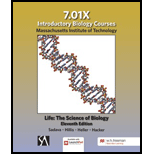
Concept explainers
To review:
Difference, reason, and type of response (induced or constitutive) given by plants to respond to two types of herbivory.
Introduction:
Some herbivores feed on plants like Nicotiana attenuata (tobacco plant). This plant produces nicotine as a secondary metabolite to defend itself. The response of plant can be of two types; one in response to mechanical damage and other in response to the predation by the animal.
Explanation of Solution
Plant defense against the herbivory explains the kind of adaptations, which are evolved by the plants for improving their survival and the reproduction via reducing the impact of the herbivores. The defenses are of two kinds, namely, constitutive and induced.
| Constitutive defenses | Induced defenses |
| These are always present in the plant. | These are generated or mobilized to the point wherein the plant is injured. |
| Wide range of composition along with the concentration, which ranges from mechanical defenses to digestibility reducers and toxins. | They produce secondary |
Amount of nicotine produced in the two types of defenses is different. In case of mechanical injury (wound), a higher amount of nicotine is produced as compared to herbivory by Manduca sexta (caterpillar of tobacco hornworm). The caterpillar suppresses the nicotine production in tobacco plants with the help of hormone ethylene.
Thus, this type of response is an induced response. Ethylene production by worm suppresses nicotine production in tobacco plants. It is able to predate upon the plant without any ill effects. Mechanical injury, on the other hand, suppresses the nicotine production to a lesser extent.
Want to see more full solutions like this?
Chapter 38 Solutions
LIFE:SCIENCE OF BIOL.(LL) >CUSTOM<
- Briefly illustrated the mechanism of analgesic action of morphine? explain at your own wordsarrow_forwardHumans synthesize most of the cholesterol required for cellmembranes and for the synthesis of vitamin D and steroidhormones. What would you expect to happen if a person’sdiet is high in cholesterol? Provide a reason for your response.arrow_forwardPlant-to-plant signalling in response to herbivory is mediated by Select one: a)lignin deposition b)abscisic acid c)the anti-malarial molecule artemisin d)volatile organic compoundsarrow_forward
- Explain in detail the funcations and signalling of ephrin receptors. Provide examples.arrow_forwardDraw a bar graph showing territorial aggression in mice is dependent on estradiol, and another showing what it would the results would look like if territorial aggression was independent of estradiol.arrow_forwardDiscuss the effects of overproduction of thyroxine on humanarrow_forward
- Hint: ANSWER. * A client who is unresponsive to painful stimuli is at greatest risk for developing pressure ulcers. * Due to lack of sensory perception patient fail to observe changes in the skin integrity which increases the chances of developing pressure ulcer.arrow_forwardDuring the stress response, glucocorticoids and catecholamines work synergistically (together) to exert what effect? Question 2 options: to promote immune suppression to promote vasoconstriction to promote vigilance and arousal to promote hyperglycemiaarrow_forwardBlood-feeding insects such as mosquitoes inject an anticoagulant into the victims bloodstream. How does this benefit the insect?arrow_forward
- Describe high altitude sickness.What are its symptoms?arrow_forwardDescribe high altitude sickness. What are its symptoms?arrow_forwardWhich drug is afull agonist at opioid receptors with analgesics activitiy equivalent to morphine, a linger duration of action and fewer with drawal sign on abrupt discontinuance than morphine?? 1-fentanyl 2-methadone 3- Nalbuphinearrow_forward
 Human Biology (MindTap Course List)BiologyISBN:9781305112100Author:Cecie Starr, Beverly McMillanPublisher:Cengage Learning
Human Biology (MindTap Course List)BiologyISBN:9781305112100Author:Cecie Starr, Beverly McMillanPublisher:Cengage Learning
